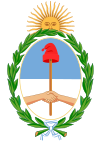Argentine Chamber of Deputies
Chamber of Deputies of the Nation Cámara de Diputados de la Nación | |
|---|---|
| 2019–2021 period | |
 | |
| Type | |
| Type | of the National Congress of Argentina |
Term limits | None |
| Leadership | |
President | |
1st Vice President | |
First Minority Leader | |
Second Minority Leader | |
| Structure | |
| Seats | 257 (List) |
 | |
Political groups | Government (120)
Opposition (137)
|
Length of term | 4 years |
| Elections | |
Voting system | Party-list proportional representation D'Hondt method |
Last election | 27 October 2019 (130 seats) |
Next election | 14 November 2021 (127 seats) |
| Meeting place | |
 | |
| Chamber of Deputies, Congress Palace, Buenos Aires, Argentina | |
| Website | |
| hcdn.gob.ar | |
Coordinates: 34°36′34.75″S 58°23′33.29″W / 34.6096528°S 58.3925806°W
The Chamber of Deputies (Spanish: Cámara de Diputados de la Nación) is the lower house of the Argentine National Congress (Spanish: Congreso de la Nación). It is made up of 257 national deputies who are elected in multi-member constituencies corresponding with the territories of the 23 provinces of Argentina (plus the Federal Capital) by party list proportional representation. Elections to the Chamber are held every two years, so that half of its members are up in each election, making it a rare example of staggered elections used in a lower house.
The Constitution of Argentina lays out certain attributions that are unique to the Chamber of Deputies. The Chamber holds exclusive rights to levy taxes; to draft troops; and to accuse the President, cabinet ministers, and members of the Supreme Court before the Senate. Additionally, the Chamber of Deputies receives for consideration bills presented by popular initiative.
The Chamber of Deputies is presided over by the President of the Chamber (Spanish: Presidente de la Cámara), who is deputized by three Vice Presidents.
Current composition[]
It has 257 seats and one-half of the members are elected every two years to serve four-year terms by the people of each district (23 provinces and the Autonomous City of Buenos Aires) using proportional representation, D'Hondt formula with a 3% of the district registered voters threshold, and the following distribution:
By province[]
| Province | Deputies | Population (2010) |
|---|---|---|
| Buenos Aires City | 24 | 2,890,151 |
| Buenos Aires | 70 | 15,625,084 |
| Catamarca | 5 | 367,828 |
| Chaco | 7 | 1,053,466 |
| Chubut | 5 | 506,668 |
| Córdoba | 18 | 3,304,825 |
| Corrientes | 7 | 993,338 |
| Entre Ríos | 9 | 1,236,300 |
| Formosa | 5 | 527,895 |
| Jujuy | 6 | 672,260 |
| La Pampa | 5 | 316,940 |
| La Rioja | 5 | 331,847 |
| Mendoza | 10 | 1,741,610 |
| Misiones | 7 | 1,097,829 |
| Neuquén | 5 | 550,334 |
| Río Negro | 5 | 633,374 |
| Salta | 7 | 1,215,207 |
| San Juan | 6 | 680,427 |
| San Luis | 5 | 431,588 |
| Santa Cruz | 5 | 272,524 |
| Santa Fe | 19 | 3,200,736 |
| Santiago del Estero | 7 | 896,461 |
| Tierra del Fuego | 5 | 126,190 |
| Tucumán | 9 | 1,448,200 |
By political groups[]
All data from official website.[1]
| Alliance | Party | Leader | |
|---|---|---|---|
| Everybody's Front (120) | Máximo Kirchner | ||
| Together for Change (115) (President: Mario Negri) |
PRO (53) | Cristian Ritondo | |
| Radical Civic Union (46) | Mario Negri | ||
| Civic Coalition (14) | Maximiliano Ferraro | ||
| Production and Labour (1) | Marcelo Orrego | ||
| Federal (10) (President: Alejandro "Topo" Rodríguez) |
Federal Córdoba (4) | Carlos Gutiérrez | |
| Federal Consensus (3) | Alejandro "Topo" Rodríguez | ||
| Justicialist (1) | Andrés Zottos | ||
| Progressive, Civic and Social Front (1) | Luis Contigiani | ||
| Socialist Party (1) | Enrique Estévez | ||
| Federal Unity for Development (6) (President: José Luis Ramón) |
Misiones Front for Concord (3) | Ricardo Wellbach | |
| Federal Unity and Equity (2) | José Luis Ramón | ||
| Together We Are Río Negro (1) | Luis Di Giacomo | ||
| Federal Action (2) | Felipe Álvarez | ||
| Socialist Left–Left Front (2) | Juan Carlos Giordano | ||
| Party for Social Justice (1) | Beatriz Ávila | ||
| Neuquén People's Movement (1) | Alma Sapag | ||
Requirements[]
In order for an Argentine citizen to be elected to congress, they have to fulfill certain requirements: He or she has to be at least twenty five years old with at least four years of active citizenship and it has to be naturalized in the province that is being elected to or at least have two years of immediate residency in said province, according to art. 48 of the Argentine Constitution.
History[]
The Chamber of Deputies was provided for in the Constitution of Argentina, ratified on May 1, 1853. Eligibility requisites are that members be at least twenty-five years old, and have been a resident of the province they represent for at least two years; as congressional seats are elected at-large, members nominally represent their province, rather than a district.[2]
Otherwise patterned after Article One of the United States Constitution per legal scholar Juan Bautista Alberdi's treatise, Bases de la Constitución Argentina, the chamber was originally apportioned in one seat per 33,000 inhabitants. The constitution made no provision for a national census, however, and because the Argentine population doubled every twenty years from 1870 to 1930 as a result of immigration (disproportionately benefiting Buenos Aires and the Pampas area provinces), censuses were conducted generationally, rather than every decade, until 1947.[3]
Apportionment controversy[]
The distribution of the Chamber of Deputies is regulated since 1982 by Law 22.847, also called Ley Bignone, enacted by the last Argentine dictator, General Reynaldo Bignone, ahead of the 1983 general elections. This law established that, initially, each province shall have one deputy per 161,000 inhabitants, with standard rounding; after this is calculated, each province is granted three more deputies. If a province has fewer than five deputies, the number of deputies for that province is increased to reach that minimum.
Controversially, apportionment remains based on the 1980 population census, and has not been modified since 1983; national censuses since then have been conducted in 1991, 2001, and 2010. The minimum of five seat per province allots the smaller ones a disproportionately large representation, as well. Accordingly, this distribution does not reflect Argentina's current population balance.
Presidents of the Chamber[]
The President of the Chamber is elected by the majority caucus. The officeholders for this post since 1983 have been:
| President | Party | Term start | Term end | Province | |
|---|---|---|---|---|---|
| Juan Carlos Pugliese | UCR | 29 November 1983 | 3 April 1989 | ||
| Leopoldo Moreau | UCR | 26 April 1989 | 6 July 1989 | ||
| PJ | 6 July 1989 | 1 December 1999 | |||
| UCR | 1 December 1999 | 5 December 2001 | |||
| Eduardo Camaño | PJ | 5 December 2001 | 6 December 2005 | ||
| Alberto Balestrini | PJ–FPV | 6 December 2005 | 12 December 2007 | ||
| Eduardo Fellner | PJ–FPV | 12 December 2007 | 6 December 2011 | ||
| Julián Domínguez | PJ–FPV | 6 December 2011 | 4 December 2015 | ||
| Emilio Monzó | PRO–C | 4 December 2015 | 10 December 2019 | ||
| Sergio Massa | FDT | 10 December 2019 | incumbent | ||
Current authorities[]
Leadership positions include:
| Title | Officeholder | Party | Province |
|---|---|---|---|
| Chamber President | Sergio Massa | Everybody's Front | |
| First Vice-President | Omar De Marchi | PRO-Together for Change | |
| Second Vice-President | José Luis Gioja | Everybody's Front | |
| Third Vice-President | Alfredo Cornejo | UCR-Together for Change | |
| Parliamentary Secretary | Eduardo Cergnul | ||
| Administrative Secretary | Rodrigo Rodríguez | ||
| Coordinating Secretary |
See also[]
- Argentine Senate
- Politics of Argentina
- List of legislatures by country
References[]
- ^ Bloques e interbloques - Cámara de Diputados de la Nación Argentina
- ^ Honorable Senado de la Nación: Constitución Nacional Archived 2012-05-13 at the Wayback Machine (in Spanish)
- ^ Indec: Historia de los censos Archived 2016-05-09 at the Wayback Machine (in Spanish)
External links[]
| Wikimedia Commons has media related to Parliaments of Argentina. |
- National lower houses
- Government of Argentina
- National Congress of Argentina

